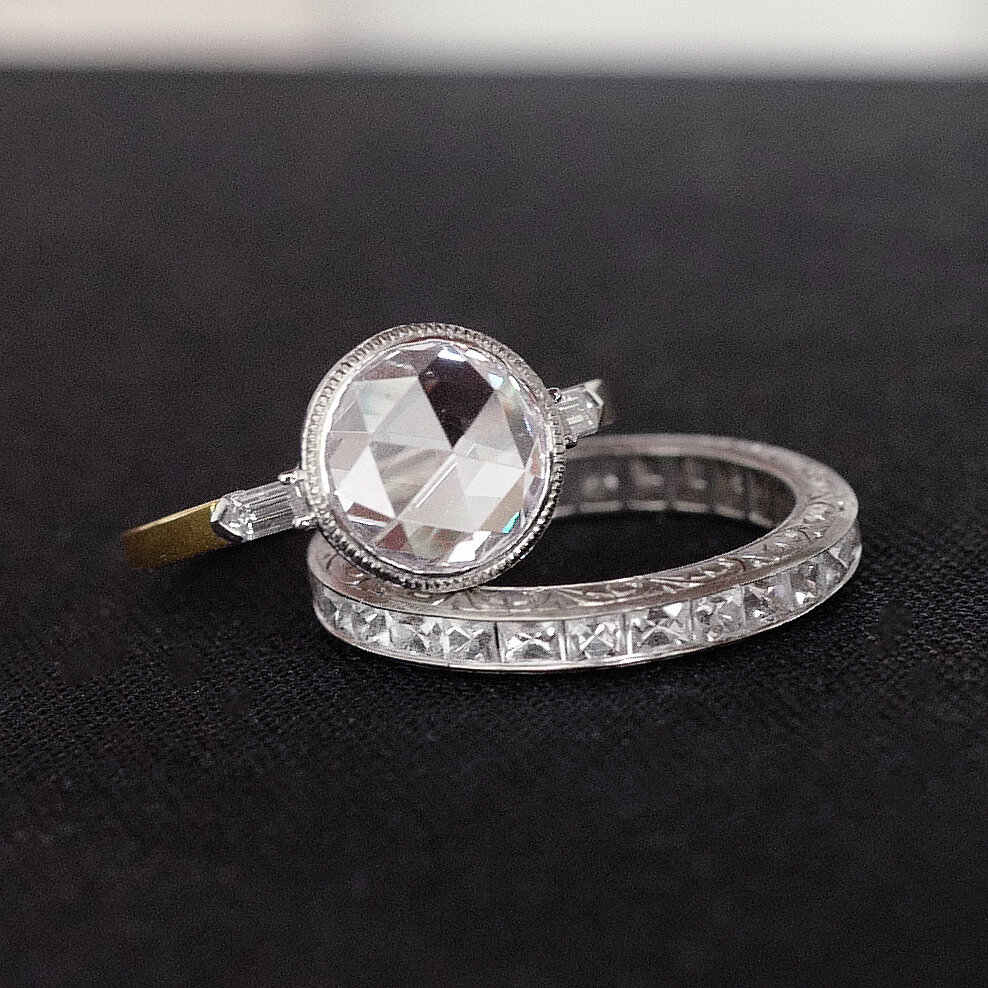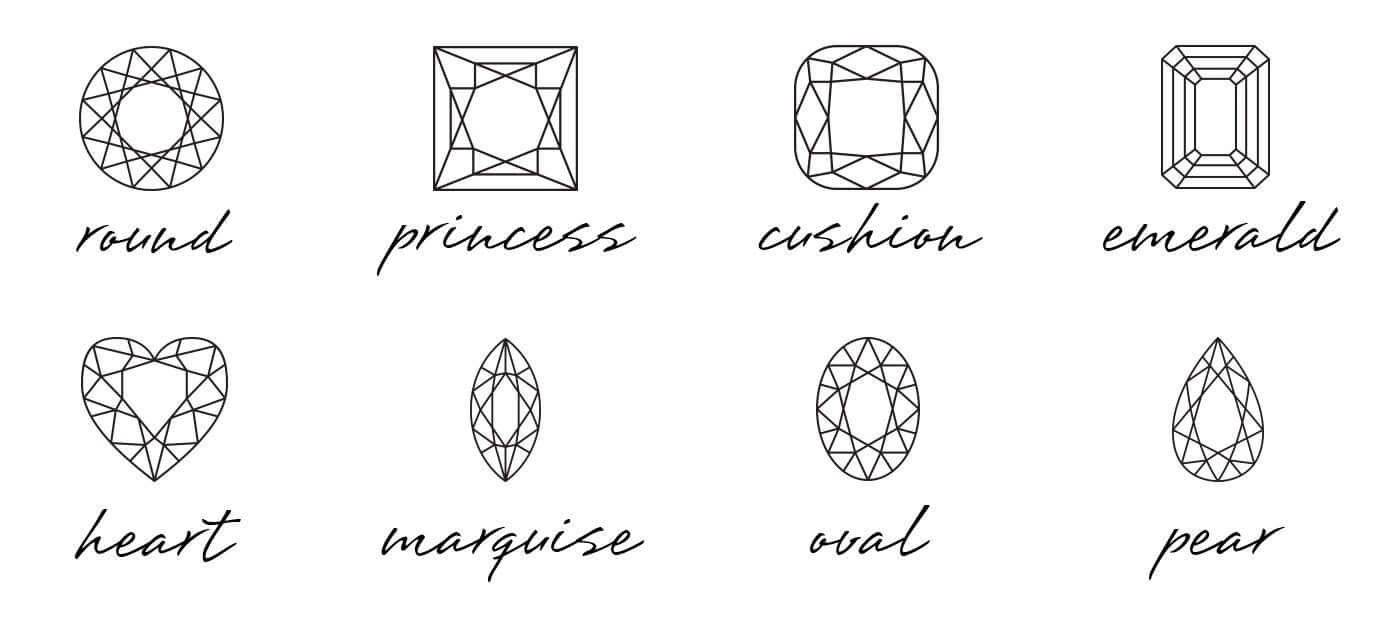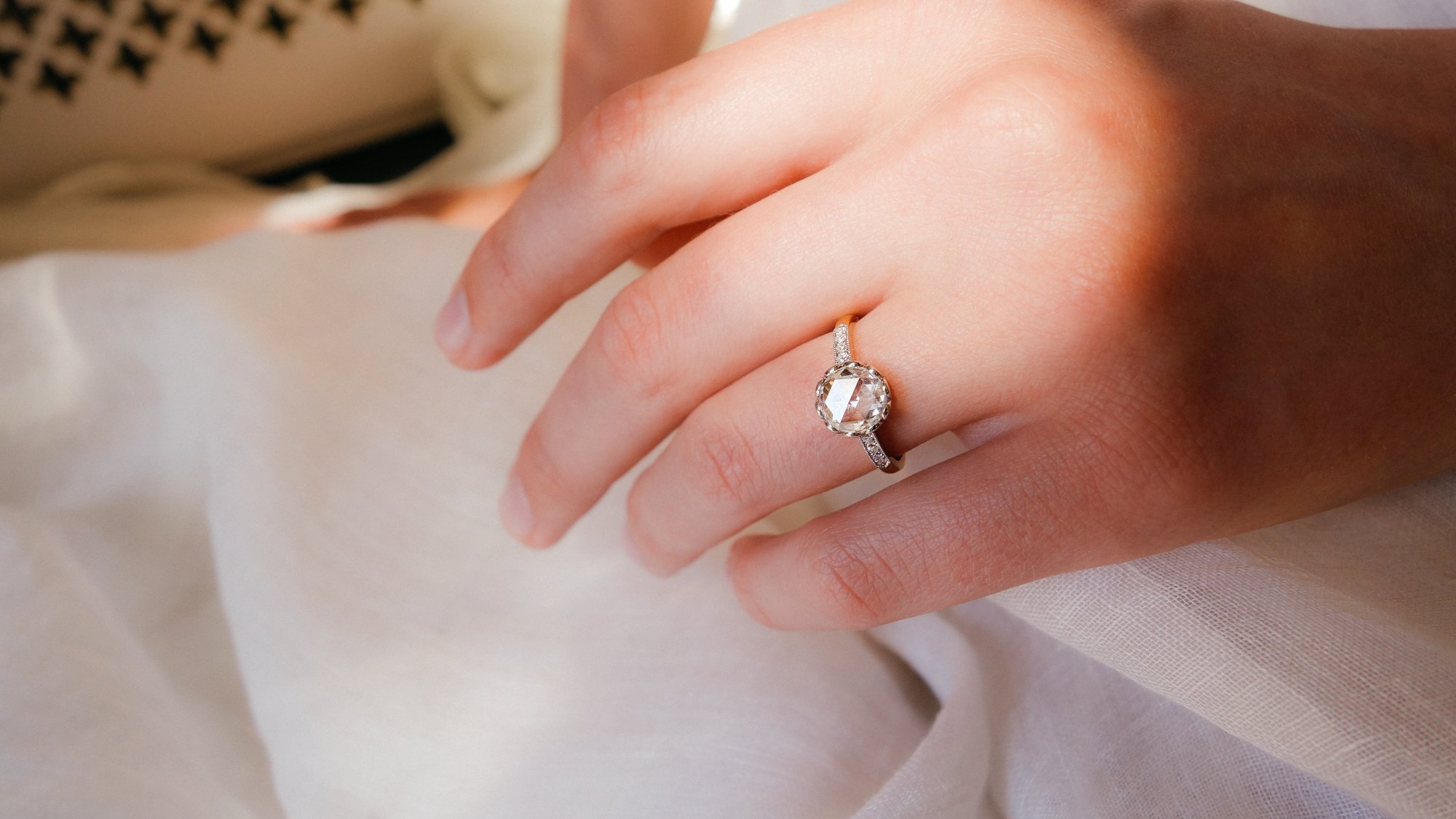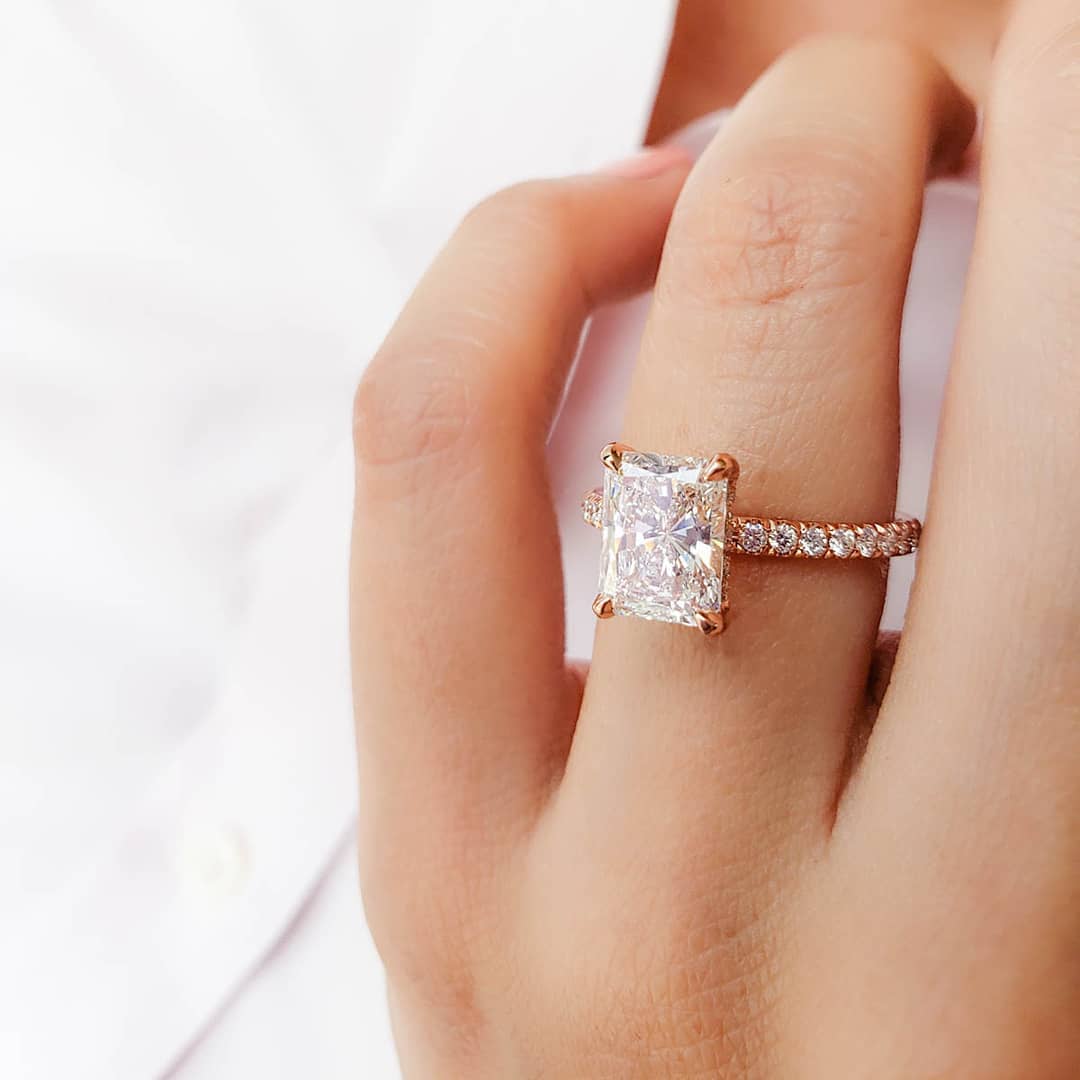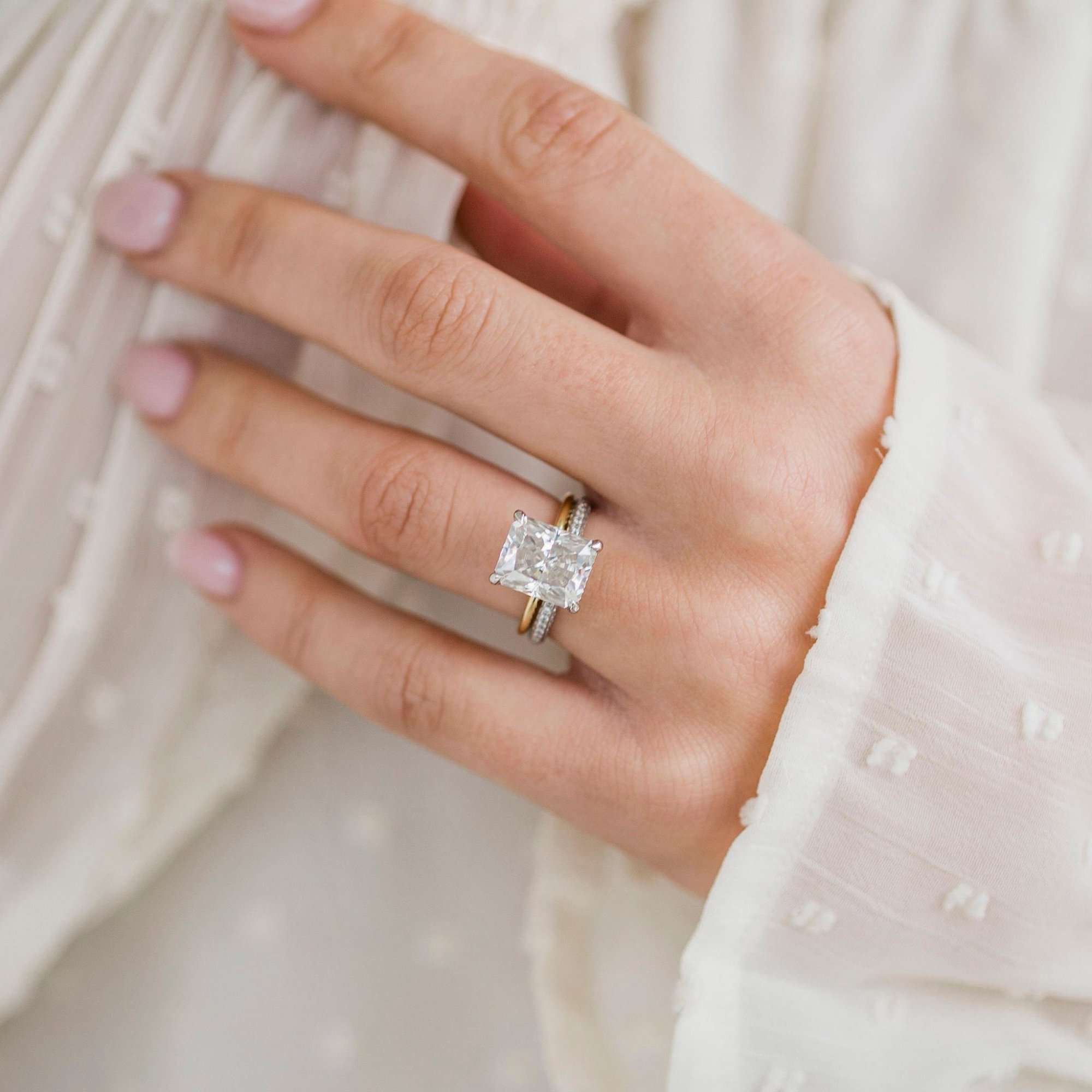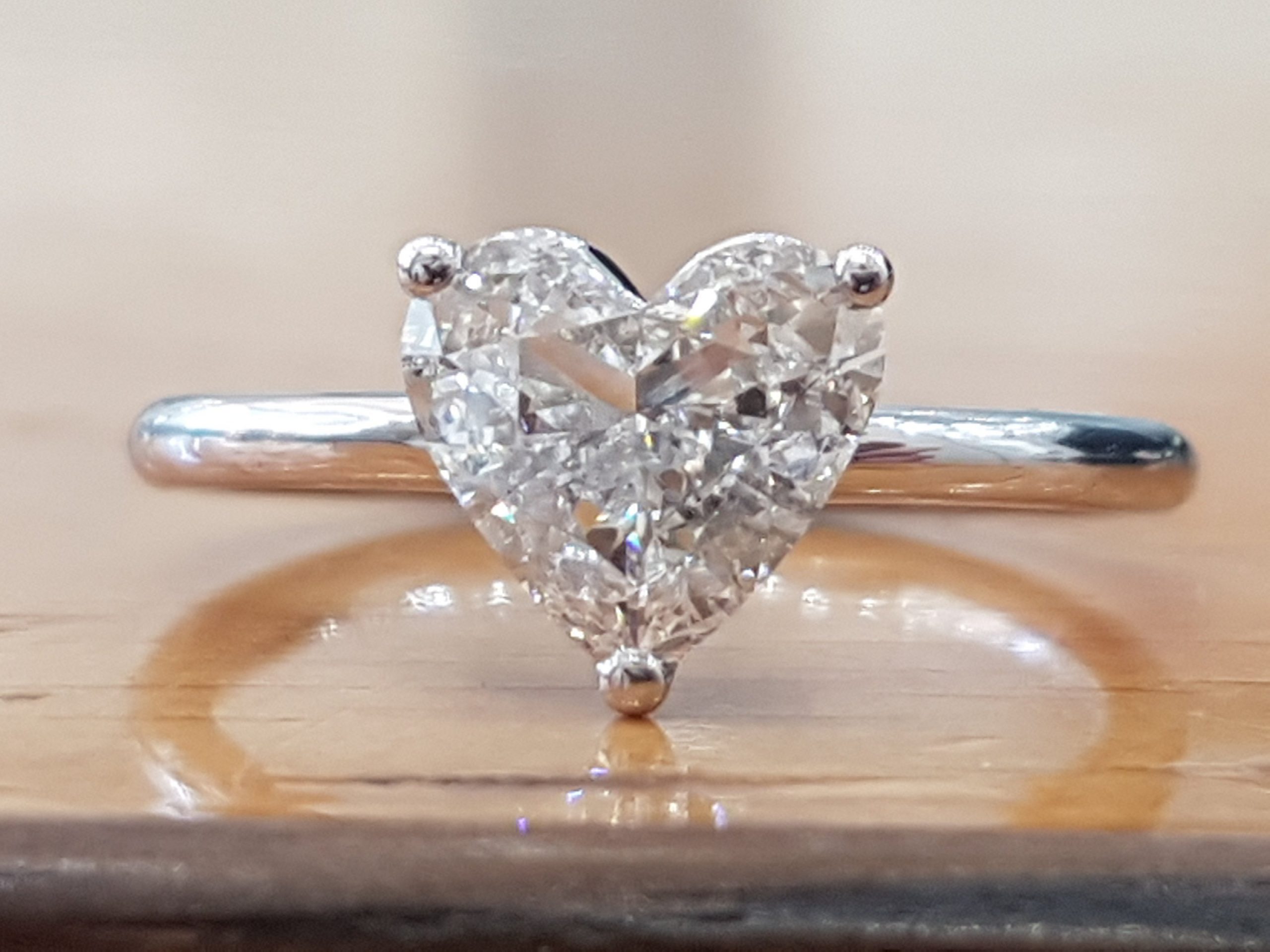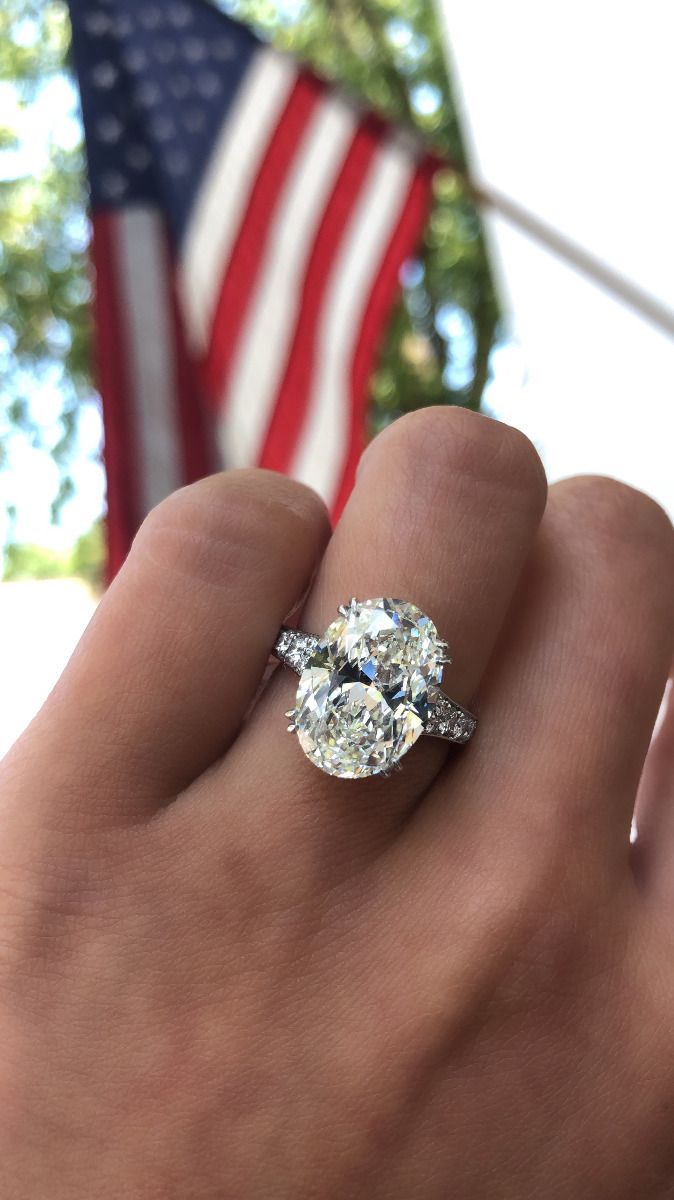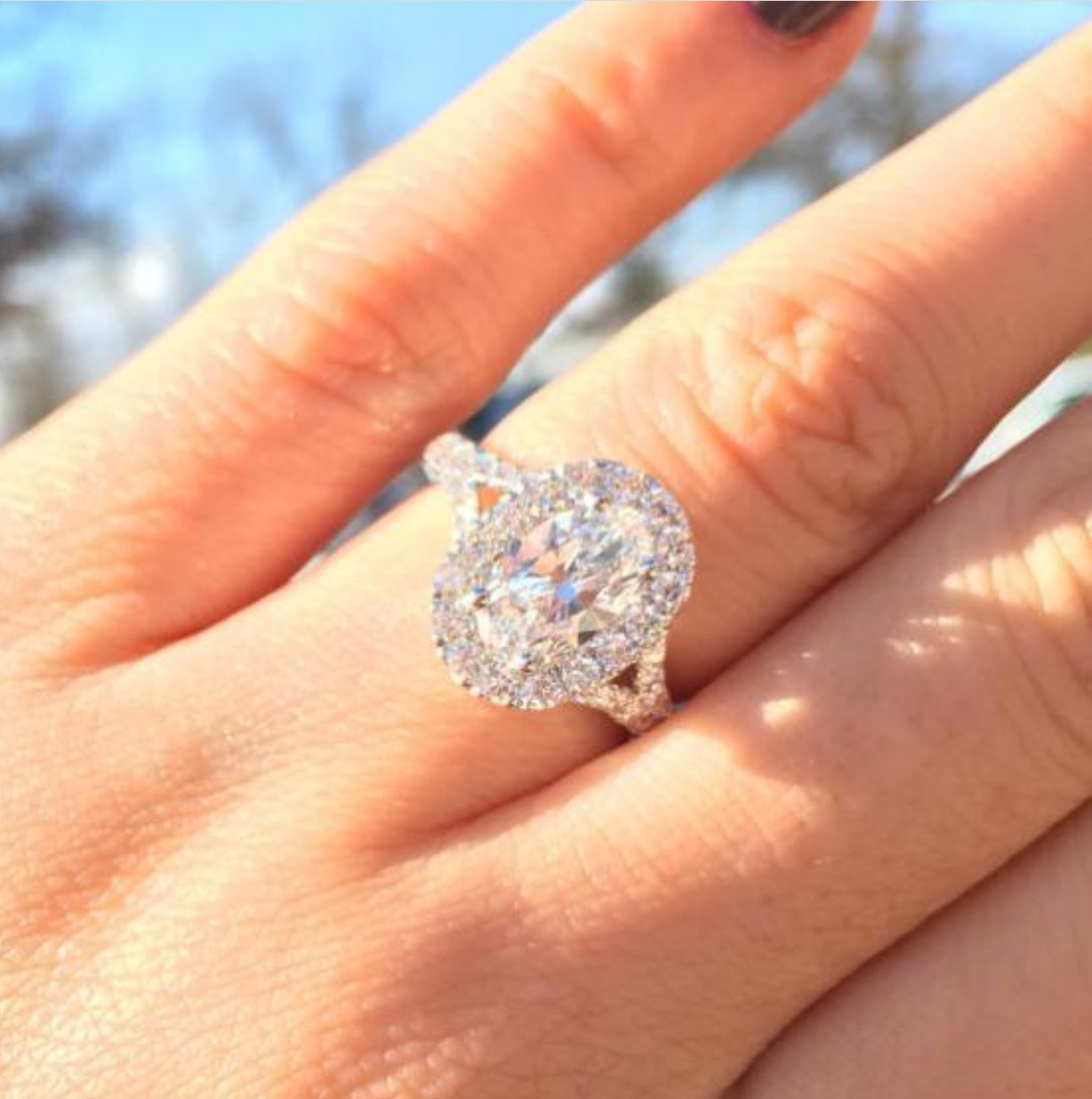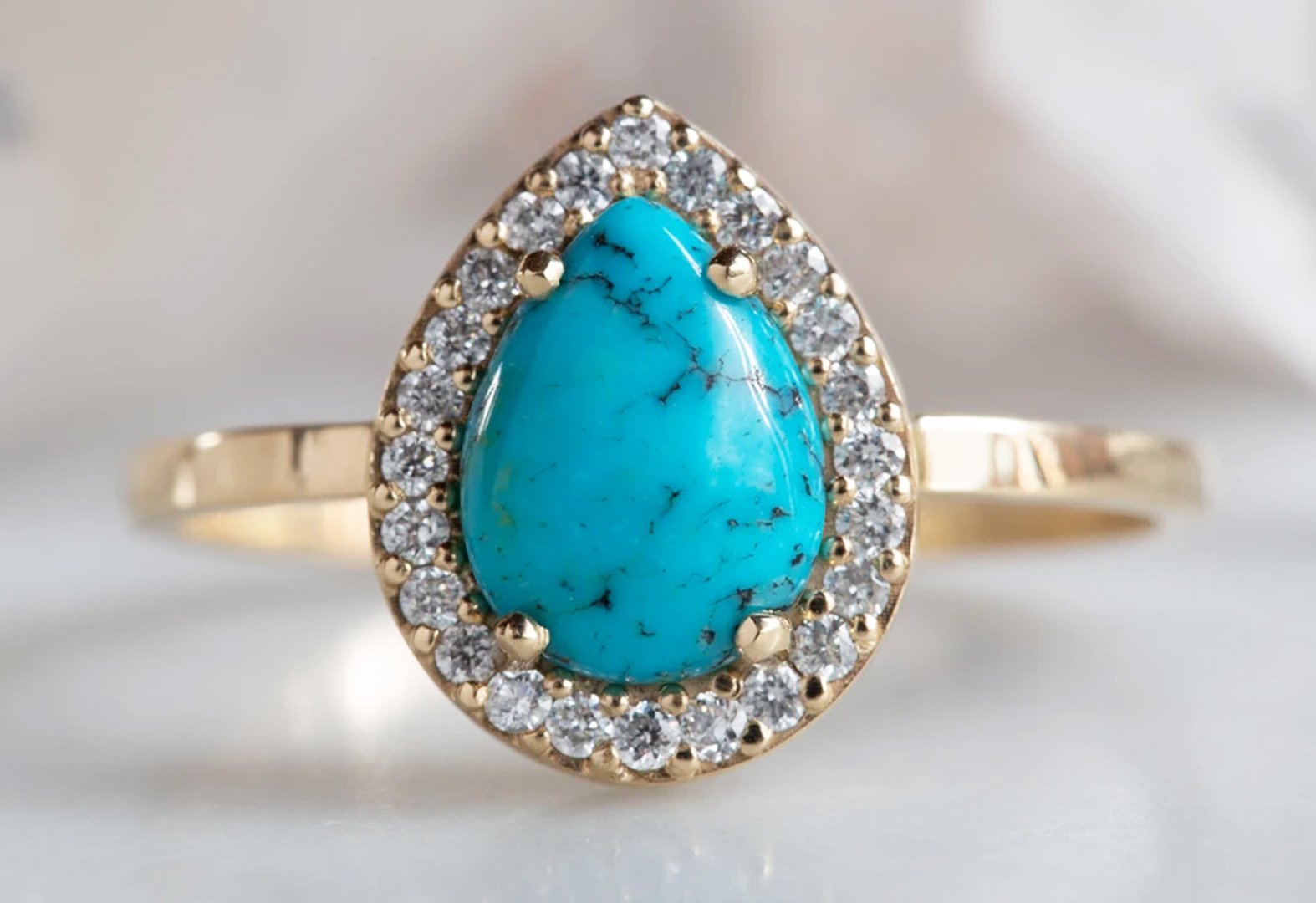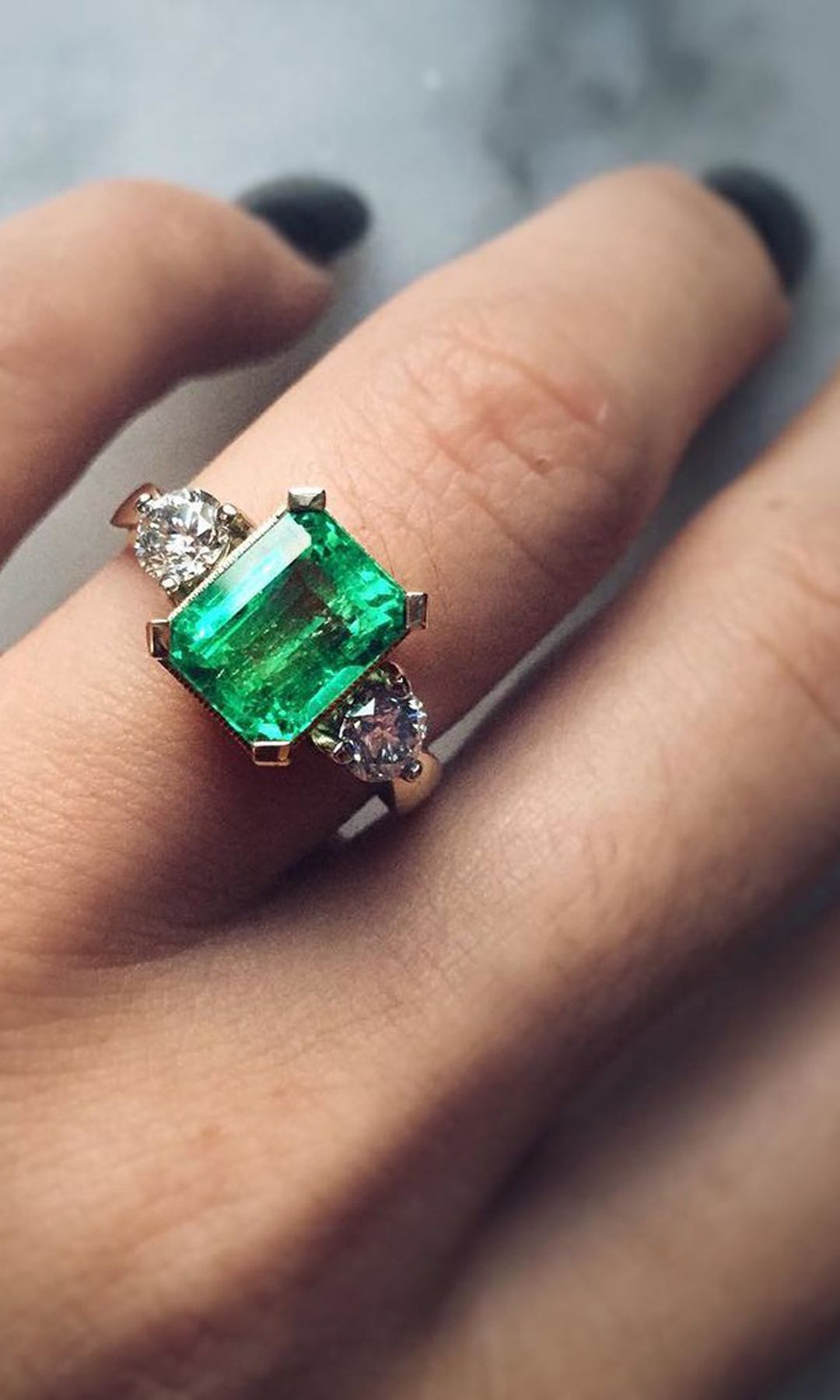A. The 12 Most Popular Diamond Shapes For Engagement Rings
It’s no secret that cutting the keystone makes all the difference when it comes to finding the engagement ring of your dreams. Each one shines in its own way and deciding which one is a good starting point. Think about what’s important to you in everyday jewelry. Do you go for a more modern look or do you tend to go to consignment stores for your next big vintage find? Do you want to elongate the look of your fingers or do you prefer a rock that looks huge? All of these factors depend on the stone cut and, luckily for you, we are here to analyze them.
The most popular diamond cut for engagement rings is a round diamond. Brilliant cut round diamonds are the quintessential sparkler due to their excellent light output and universal shape that works in a multitude of setting styles. If you know what type of setting you want but aren’t sure which type of diamond works best, a brilliant-cut round diamond is probably the way to go, especially if you prefer a classic look. But of course there are options for all types of brides. Consider a princess cut diamond for a bolder, more modern look, with as much sparkle as a round diamond. Or, if you love vintage settings, opt for a pillow-cut diamond that offers an elegant sparkle and an old-world feel. Step cut diamonds like Asscher and Emerald are smooth and sharp and also have more transparency than other cuts. Radiant cut diamonds mimic the shape of an emerald, but have more facets for greater brilliance.
For something more unique, pear, marquise and oval diamonds stand out and make your fingers look longer, while trillions of cut diamonds sparkle in a modern triangle shape. For the discreet bride, opt for a baguette diamond band that goes against the idea of a central stone. And only for the most romantic are there heart-shaped diamonds that somehow speak for themselves. If you are a bride looking for something “new” or a more vintage inspired style, here are the 12 most popular diamond cuts for engagement rings.
1. Round cut
Brides everywhere gather in round cut diamonds. Given that its shape maximizes the diamond’s fire with the correct reflection of light, it’s no surprise that this is the reigning stone (we’re all guilty of falling for a good shine). Round diamonds with brilliant cut are well suited as solitaires, in two and three stone settings and even in geometric settings for a retro look. These diamonds make great brides who love the classics, but if you’re on the alternative side, consider a cut that shows up in fewer fingers.
2. Princess cut
What bride doesn’t want to feel like a princess on her big day? Enter the princess cut of the same name, another popular style of engagement ring. The versatile face-up shape of the princess cut – complete with square or rectangular sides – makes it a superior choice for almost any style of ring. They have a more modern, geometric look but still offer a lot of sparkle and are generally much cheaper than the more popular round cut diamonds. Be sure to choose a protective setting, however, as princess cut diamonds are known to chip or fall out in corners.
3. Pillow cut
This exquisite cut is often compared to a pillow, thanks to its combination of square cut with rounded corners, which in combination with the classic 58 larger facets of the cut enhances the stone’s shine. Cut diamonds have been around since the 18th century and were huge in the 19th century, when most cut gemstones were cut (however, it was called mine cut at the time). They’ve been gaining in popularity lately and exude a total old-world vibe that’s perfect for vintage environments. They sparkle less intensely than brilliant cut diamonds, and while they look great in modern surroundings, they are not the most modern.
4. Emerald cut
Characterized by a rectangular cut, open table and cut corners, the emerald-cut diamond is often preferred for its Art Deco aesthetic. Although it glows subtly – some call it a “mirror corridor” effect – its long silhouette and angular lines capture the clarity of the diamond and, at the same time, capture the light dramatically. When set vertically, its shape makes the fingers look longer and thinner, perfect for selfies with engagement rings. However, as it has fewer facets that distract from the blemishes, clarity and color are essential. It’s not a super flashy style either, so if you’re looking for a mega sparkling wine this isn’t the cut for you.
5. Cut awning
The marquise cut, also known as the navette cut, is known for its majestic touch. Its distinctive silhouette is characterized by curved sides and sharp edges – an elegant football shape, if you will. Its long, narrow shape not only creates an illusion of larger size, it also elongates the finger when oriented vertically. Also, it shines with a brilliant shine. However, due to the delicate sharp edges, there is a risk of peeling and breakage if the ring is not adjusted correctly. It also tends to have what is called a “fly” appearance in the center of the diamond. If the ring is not well cut, it can be very noticeable and generally undesirable.
6. Oval cut
Essentially an elongated version of a round diamond, the oval diamond can have as many facets as a round cut stone, meaning it can shine as brightly. It’s an elegant and extraordinary choice, and its elongated shape can elongate your finger. However, if not cut correctly, it tends to have a “flying” effect similar to a stone cut in a marquee, and also tends to have imperfections and inclusions. One way to combat this is to choose an oval-cut salt and pepper diamond so that unwanted inclusions become an essential part of your look.
7. Radiant cut
A radiant-cut diamond invented by Henry Grossbard in 1977 lives up to its name and captures light in a big way. The shape mimics an emerald-cut stone, but the unique, deeply indented facets add extra shine. Brides who don’t want to stray too far from classic shapes will appreciate the timeless nature and personalized spirit of this stone. It doesn’t have the sharp edges of a princess cut diamond as it actually has eight corners, which minimizes the chance of chipping. If you want a large stone, the bright cut may not be right for you, as the deep cuts make the stone look smaller. It’s also quite rare, so you might not be able to find a wide variety of stones in this cut to choose from.
8. Pear cut
The pear-shaped diamond, also known as a teardrop, is a mix of styles that dates back to the 14th century. Based on the oval and marquise, this unique shape is the perfect choice for vintage-inspired brides who follow their own rules and believe that two is better than one. As more stones are visible when viewed from above, pear-shaped diamonds tend to look larger than they are. So if size is important to you, this cut is a great choice. Since the pear cut has a pointed tip, these rings work best in a bevel or half-V setting as they are prone to chipping. They also tend to show inclusions and can be less shiny if not cut correctly.
9. Cut asscher
The Asscher cut has been a favorite with fashionistas since Carrie Bradshaw modeled an Asscher cut during her brief engagement to Aidan Shaw in Sex and the City. Named after the jeweler who patented the design in 1902, the Asscher cut has an octagonal shape with 58 large staggered facets. Popular during the Art Deco era, its unique symmetrical geometric design still retains its sparkle and shine. As it has no sharp edges, it is not prone to breakage and looks good in a variety of configurations. However, this cut requires you to invest in a high quality diamond with a lot of clarity as it is subject to tarnishing.
10. Heart cut
As an eternal symbol of love, heart-cut stones are not traditionally worn as engagement rings, nor are they limited to Valentine’s Day weddings. But maybe that’s what makes it so special. For desperate romantics, this contemporary cut offers a feminine form that looks good on a simple ribbon or in a more elaborate setting. As this is a slightly intricate cut, you may need to pay more for the work involved in creating the symmetry and sparkle that makes a heart-shaped stone shine. It is also considered a bit modern by some. So if you’re looking for something undeniably timeless, this might not be the ring for you.
11. Baguette cut
Another Art Deco-style baguette diamond from the 1920s has a long rectangular shape and 14 facets. In the picture above, between the two gold bands, the baguette diamond bands are ideal for the bride who is not interested in a flashy center stone. However, they are more commonly used as accent diamonds in many engagement rings, ie three stone engagement rings. You can combine a large center stone with a baguette diamond on both sides for a modern look. With these stones, the clarity of the few facets is as important as the precision of the cut.
12. Trillions cut
Trillions of cut diamonds originating in the Netherlands are a popular choice for alternative brides looking for a unique ring. They have a triangular shape with rounded or pointed edges and a flat cut that makes them look bigger than they are. Stones cut by trillions of stones are ideal as accents or as the main stone in a three stone ring, but they also look great as a solitaire. Because of the sharp edges of most trillions of cut diamonds, they often need a bezel or three-prong configuration to prevent chipping. While not as shiny as other cuts, they do have an elegant sheen, making them a great choice for brides looking for a medium-sized sparkling wine.
B. Top 8 Most Popular Diamond Cuts For Engagement Rings
The most important part and often the most expensive part of an engagement ring is the main diamond. A girl usually has a favorite diamond that she would like to wear as the main diamond on her ring. In this article, we are going to discuss the most popular diamond cuts used in engagement rings. At Diamond Exchange Houston, our goal is always to provide our customers with the biggest and most beautiful diamonds for their specific budget.
The center stone cut in a diamond engagement ring makes all the difference. Deciding which diamond shape suits you is an excellent starting point. When it comes to finding the diamond ring of your dreams, it’s worth considering the diamond cut you want. There are countless diamond cuts available, from the famous round diamond to the chic pillow, you will be inundated with a choice. Each cut of the diamond reflects light in an inimitable way. Its variety of cuts, shapes and overall appearance determine the appearance of the final ring.
1. Best Diamond Cuts for Engagement Rings
Whether you’re looking for something vintage, modern, understated or outrageous, these eight most popular engagement rings are what a married woman wears on her finger most of the time. In this section, we’ll organize them from most popular to least popular:
a. Round cut
The round cut is, without a doubt, the most popular diamond shape among all. Its round shape maximizes the stone’s fire. Round diamonds with brilliant cut are perfect for solitaire games, two-stone and three-stone configurations, as well as geometric configurations. This is the best choice for brides who prefer everything classic.
b. Princess cut
The famous princess cut is another very popular style of diamond cut. The versatile and ascending look of a princess cut is the first choice for an elegant and elegant engagement ring. The princess cut costs less than the round cut diamond but offers a geometrically modern look.
c. Pillow cut
Rounded corners combined with a square cut, which resembles the shape of a pillow, results in a wonderful pillow cut. The classic 58 solid facets enhance the diamond’s brilliance. The cushion cut diamond produced in the 18th century was then known as the ancient mine cut. Cushion cut diamonds have made a brilliant comeback in recent years.
d. Oval cut
The oval cut diamond with its oval outline offers the same brilliance as the round cut. The elongated shape with its elegant, shiny features creates the illusion of a long finger. However, a poorly cut oval diamond will definitely suffer from “the plague of the fly”, inclusions and other imperfections. An oval diamond in salt and pepper will solve this problem simply by making these inclusions an essential aspect of appearance.
e. Emerald cut
The emerald cut was celebrated for its unusual Art Deco aesthetic. The emerald cut is characterized by its open table, jagged corners and rectangular step cutouts. In contrast to the round or princess cut, it offers a subtle glow known as the “Hall-of-Mirror” effect. The angular lines and long silhouette show the diamond’s clarity and capture the light spectacularly.
f. Cut awning
The real feel of a marquise cut sets it apart from others. Its distinctive silhouette is emphasized by sharp points and curved sides. Its long, narrow shape creates the illusion of a larger size and at the same time elongates the finger when positioned vertically. However, sharp edges mean a greater risk of breakage and peeling if not adjusted correctly. On the other hand, in the center of a marquise diamond, a noticeable “fly” effect from the dark room can appear if the stone is not well cut.
g. Radiant cut
True to its title, the brilliant cut diamond captures the light superbly. The timeless features of this shape mimic the emerald cut, while its deep-cut facets add extra shine. The radiant cut with eight corners also means there is minimal risk of breakage or chipping.
h. Heart cut
As an eternal emblem of love, contemporary heart-cut diamonds are special symbols for desperate romantics. The heart diamond is an intricate cut and shows an excellent shine and exquisite symmetry of the silhouette.
